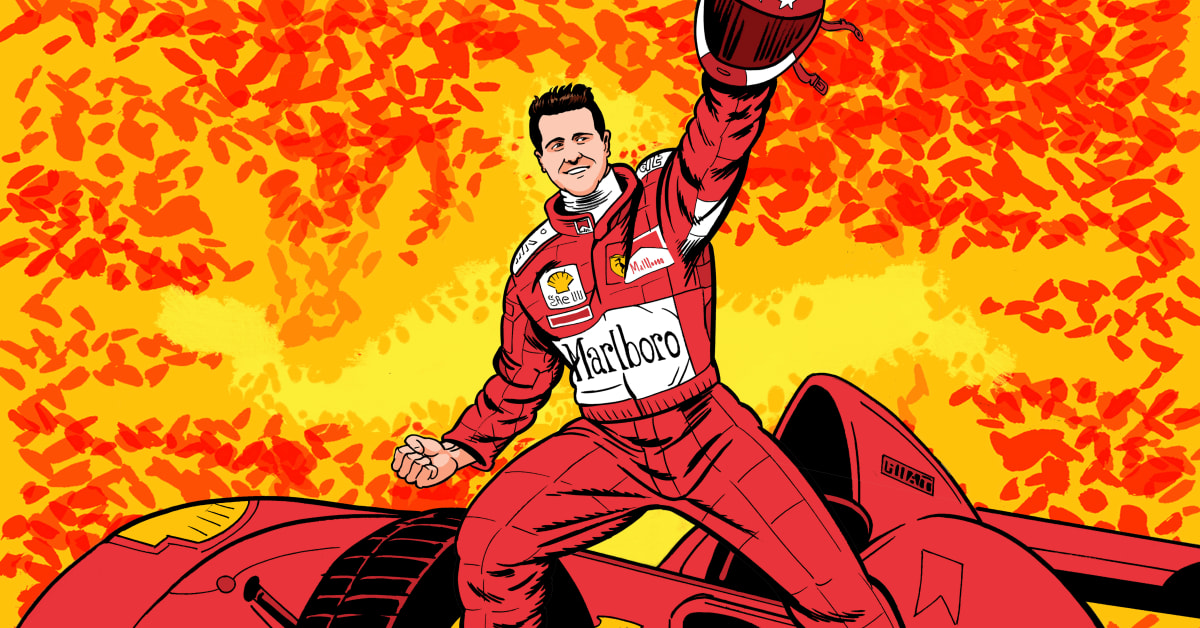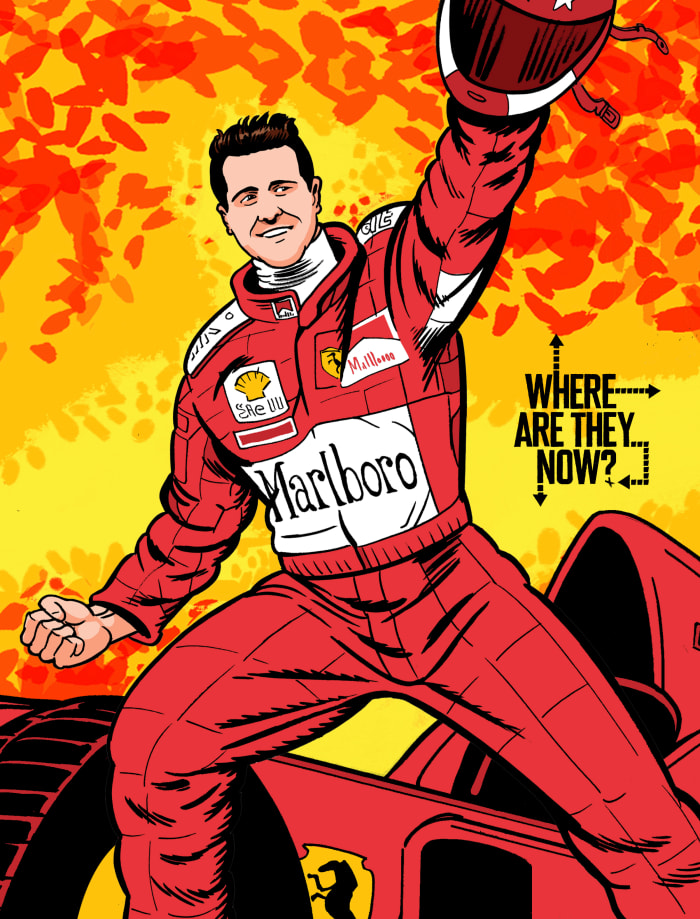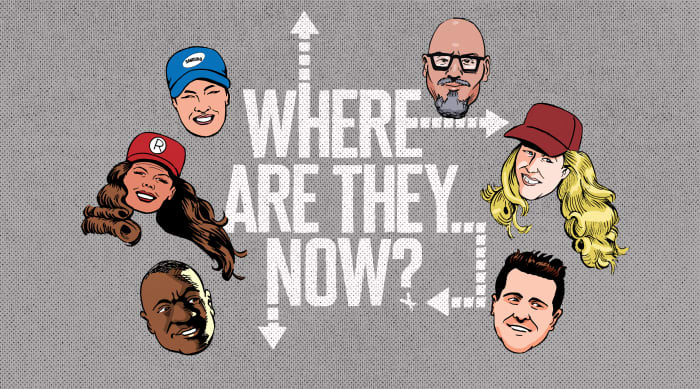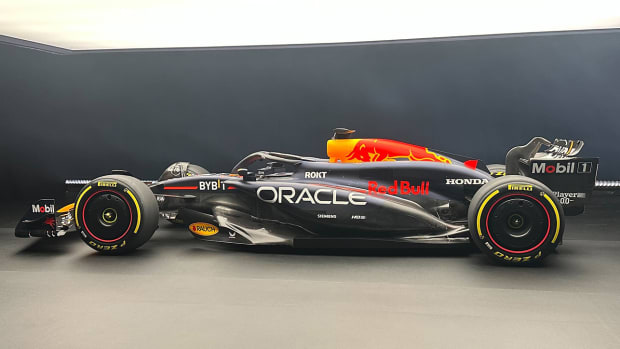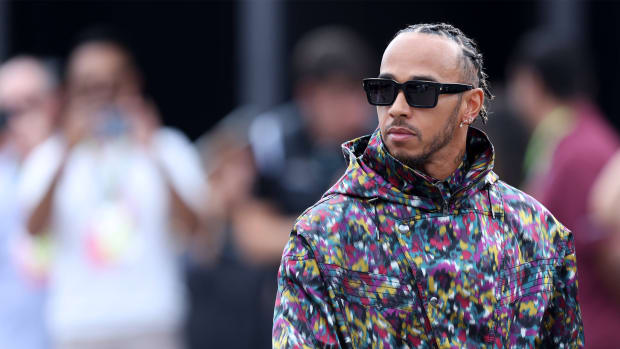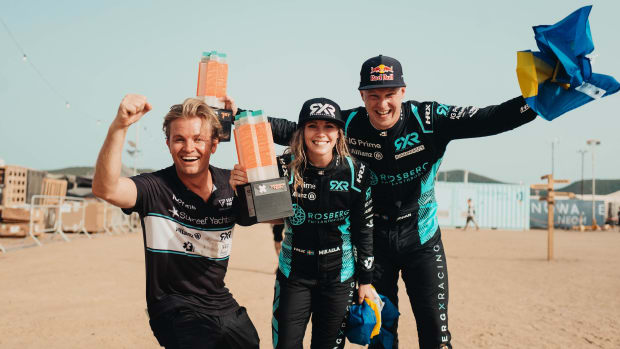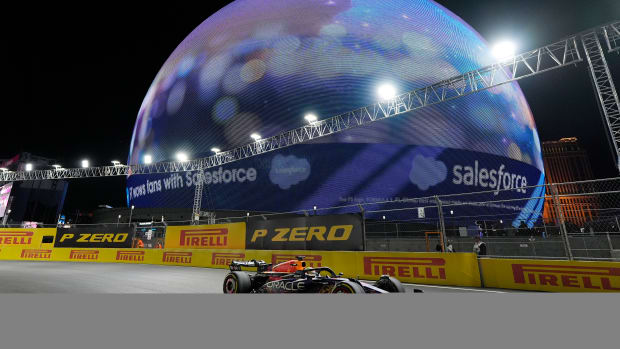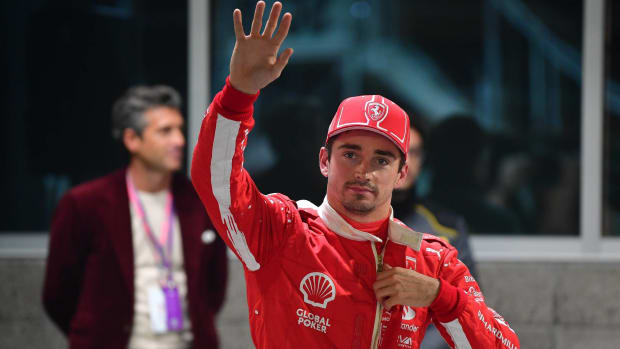Michael Schumacher Is the GOAT. Michael Schumacher Is Absent.
Each summer Sports Illustrated revisits, remembers and rethinks some of the biggest names and most important stories of our sporting past. Come back all week for more WHERE ARE THEY NOW? stories.
Head north on the E25 Highway, hugging the turns and ignoring the optional speed limit, as it curls above Gland, Switzerland, and it’s easy to feel like a European race car driver. Lausanne is up ahead. Geneva resides in the rearview mirror. Down below, the sun bounces off Lake Geneva. The whole tableau is framed by assorted snow-capped Alps, sitting regally off in the distance.
But take the exit ramp and head into Gland and there’s no indication that the greatest driver there ever was—an athlete once thought to be in competition with Tiger Woods and Michael Jordan to see who would be first to earn $1 billion—resides in the town. No museum. No plaques. No photos of him hang in shops or restaurants. There’s no sports bar or steakhouse bearing his name. No jerseys or souvenirs available for sale. In fact, if you merely mention his name at the APlus bakery or Balthasar steakhouse, the locals close ranks.
Michael Schumacher is 53 now. Though German by birth, he is a longtime resident of Gland. Twenty years ago, he and his wife, Corinna, bought Sur Le Moulin, on the shores of Lake Geneva, a mansion that recalls the estate of the von Trapp family. Notwithstanding some trips for treatment and some stealthy warm-weather escapes to Mallorca, Schumacher is believed not to have left his home in Gland in nearly a decade.
Schumacher has been out of sight from the world as he continues to recover from a severe skiing accident. Just as second- and third-hand accounts of Schumacher bounce around the racing world, rumors flit around Gland, a town of 11,000. Inside the café of Migros grocery store, Christianne Kuhn, a Gland resident, says, “We used to see him, he was among us. Now, of course, no one sees him. Maybe we see his wife sometimes riding her horses. But Michael? Never.” Says another resident, who declined to give his name: “We don’t want to forget about him. But we don’t really want to discuss, either.”
This very much mirrors the delicate challenge confronting Formula One, the sport Schumacher dominated for the better part of 20 years. F1 is, of course, vroom-vroom-vrooming in popularity, catalyzed by the compulsively watchable Netflix series Drive to Survive. This surge—catching a gear, in the parlance—is especially pronounced in the U.S., where Formula One, long a curiosity at best, has not only become the hipster sport of choice but has also siphoned fuel from NASCAR and Indy fans. Reportedly, Formula One is shopping its U.S. media rights for $75 million annually, up from the $5 million ESPN will pay through the end of 2022. And like any international breakthrough act, inevitably, it’s coming to Vegas.
All the while, the most successful driver in the sport’s history—the great F1 titan—resides behind a gate and hedges and high fence of a lakeside mansion, his status and prognosis and quality of life wrapped in secrecy and mystery.
Before there were Lewis Hamilton and Max Verstappen, there were Michael Schumacher and Ayrton Senna. It was a fledgling rivalry but had all the necessary ingredients, not least contrasts. Different men, different generations, different origin stories, different organizing principles.
Senna, nearly a decade Schumacher’s senior, was a dazzlingly accomplished Brazilian driver with charisma to burn, once described as the rare athlete that all fans felt they knew intimately. Schumacher was the arriviste, an earnest and straightforward German who embraced a sort of clipped efficiency. But when Schumacher was seated in the cockpit, his car seemed like an extension of his body. Equal parts technician and tactician, he was deeply interested in his racing team, and hacking the car and the track for every incremental advantage. He grudgingly accepted fame; he wanted little to do with celebrity. He wanted to drive and he wanted to win.
The Senna-Schumacher rivalry ended the day Senna’s life did. At the 1994 San Marino Grand Prix at Imola, Italy, Senna lost control of his Williams car and slammed into a concrete barrier. He died at age 34. Schumacher, then driving for Benetton, went on to win the race, one of his 91 victories.
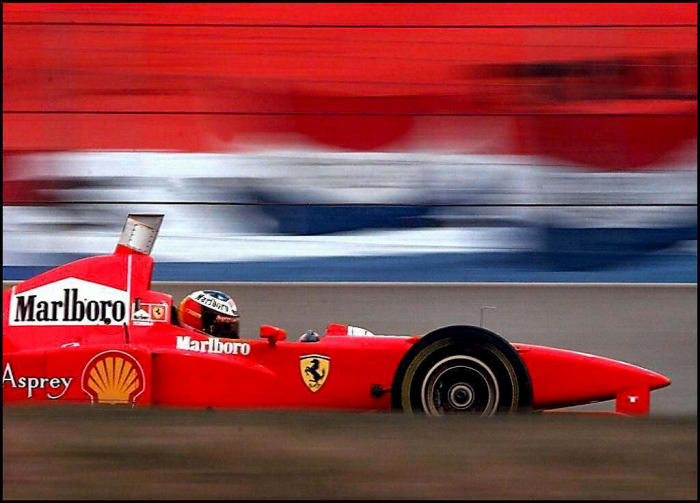
“Schumacher won a record seven World Driver’s Championships in his 19-year career, most of them driving an iconic red Ferrari.”
JEAN-LOUP GAUTREAU/AFP/Getty Images
When, immediately after the race, Schumacher inquired about Senna’s state, he was told that his rival was in a coma. In a bit of terribly heartbreaking foreshadowing, Schumacher later recalled what he thought when he first heard about Senna. “A coma can mean many things. It can just be something which can be O.K. the next day or very bad. But you don’t judge it. ...There was so little information you don’t know what you should think.”
At the podium that afternoon, Schumacher hoisted no champagne and wore a look of deep concern. Senna never came out of his coma.
After Senna’s death, Schumacher would go on to become the dominant driver not just of his era, but of any. The embodiment of confidence, the encapsulation of crisp precision, Schumacher won a record seven World Driver’s Championships in his 19-year career, most of them driving an iconic red Ferrari.
Through it all, he maintained a drawbridge between himself and the public. Roughly 20 years ago, Sports Illustrated dispatched a writer to profile Schumacher. After months of negotiating and innumerable transatlantic calls and emails, the writer was granted a brief audience with the driver. It came with a hitch: The interview was scheduled to be conducted while Schumacher worked out on his exercise bike.
In the resulting 2003 story, headlined “International Man of Mystery,” Jeff MacGregor wrote of Schumacher: “He is one of the most famous athletes in the world. He is certainly one of the two most highly paid. In his field he's likely the best there's ever been. But Michael Schumacher, like NATO or the metric system, remains a dark and distant mystery to most Americans.”
Schumacher may have kept a modest profile in the U.S., though in most of the rest of the world, he was a god. And he was compensated accordingly. For the first decade of the millennium, he was among the planet’s highest-earning athletes, jockeying for position alongside Woods or Jordan or Floyd Mayweather.

Schumacher found his way to the top of the podium often during his career.
Tobias Heyer/Bongarts/Getty Images
When Schumacher retired from competitive driving in 2012, his GOAT credentials were firmly intact. Same for his reputation. Ask F1 drivers today about their inspiration, and most will tell you it was Schumacher who sparked their interest and then set the standard for how to handle their career.
Then on Dec. 29, 2013, Schumacher was skiing with his son, Mick, at the resort of Méribel in the French Alps, not far from the family estate. He headed to an ungroomed snowfield at a high altitude. An experienced skier, Schumacher hit a rocky patch and struck his head. Though wearing a helmet, he suffered a traumatic brain injury.
The tragic irony, of course: Schumacher spent his entire career in a line of work where, literally, danger lurks behind every curve. He maneuvered a carapace of carbon fibers at 200-plus miles an hour, covering a football field of distance every second. He emerged unscathed. A 1999 accident in which he broke his leg marked the most serious injury. Then, his life in repose, it was on a ski slope that his luck ran out.
Schumacher was rushed to a hospital in Grenoble, France where, to reduce bleeding and swelling of his brain, he was placed in a medically induced coma—that state of prolonged unconsciousness that had perplexed him following Senna’s accident. Within 36 hours, Schumacher underwent two operations to relieve blood clots. The operations left other lesions deep within his brain, where they were inoperable.
In June 2014 he was transferred to Lausanne University Hospital in Switzerland. After more than six months he was relieved from his medically induced coma. Later that summer he was cleared to return home to Gland. He once relaxed by the pool and stared across the lake into France and ran in the hills to maintain his 164-pound frame. Now, his home had been retrofitted into a treatment center so Schumacher could undertake his treatments and physical therapy without going outside.
Read More Where Are They Now? Stories
When news of the accident broke, hundreds of camera crews, journalists and fans descended on the hospital and set up shop outside the facility, crowding the family members as they went to visit. According to the BBC, at the time “one tabloid journalist even disguised himself as a priest in an attempt to gain access to the ward in which Michael Schumacher was being treated.”
In the summer of 2014, an employee of the helicopter rescue company that transported Schumacher from Grenoble to Lausanne was arrested for allegedly trying to sell confidential medical records from the trip to German newspapers and websites. The attempted sale was traced through his computer and revealed his asking price: €50,000, at the time roughly $67,000. On Aug. 6, 2014, officials at the detention center where the man was being held announced that he had been found hanged in his cell.
The public has, understandably, been deeply curious and concerned over the status of an international star, recalled fondly by millions. The family has, understandably, been strenuously private, offering virtually no details about Schumacher’s quality of life, treatment or prognosis. When asked about his older brother, Ralf Schumacher, also a longtime F1 driver, has a standard response: “My family and I have agreed not to say anything on the subject.”
Formula One has taken its lead from the family. There are no tributes and scant mention of Schumacher. For this story, a French driver began to share his favorable impressions of Schumacher, but then stopped. “I’d better make sure I can discuss him.” Several days later, through a manager, the driver apologized but said he could not complete the interview.
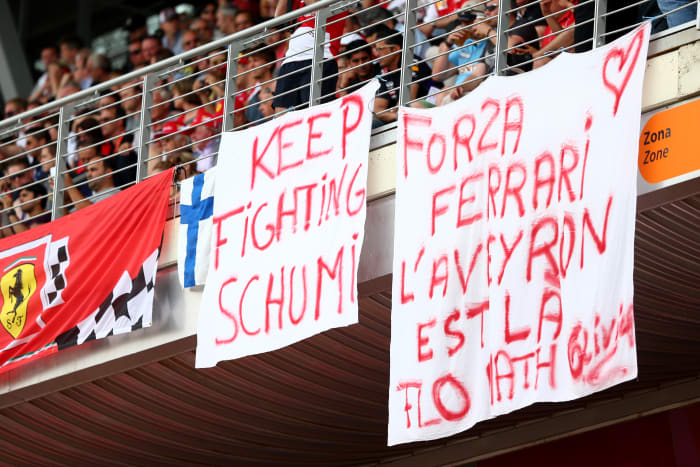
Fans hang a banner encouraging Schumacher to “keep fighting” at a 2014 Formula One race in Spain.
Clive Mason/Getty Images
In the years since, there has been plenty of speculation about Schumacher but virtually no leaks. It recalls Ruth Bader Ginsburg’s—now clearly dated—line about the secrecy of the Supreme Court: “Those that know, don’t speak. Those that speak, don’t know.” A family spokeswoman emerges occasionally to refute a particularly false or pernicious rumor. The account @schumacher—Bio: “Official twitter of F1 Legend Michael Schumacher. His “paddock” for friends, followers and fans; with thanks to all of them. Posts by #teamichael #keepfighting”—offers nostalgic clips and periodic quotes of inspiration, but no substantive updates.
Jean Todt worked alongside Schumacher at Ferrari for many years and recently retired from the role of FIA president. The Frenchman regularly visits Schumacher and shared a rare update earlier this year. "Thanks to the work of his doctors and the cooperation of Corinna, who wanted him to survive, he survived. But with consequences," Todt told the German publication Bild. "And right now [we] are fighting the consequences. We hope that things will slowly but surely improve."
Perhaps the most insight was provided in Schumacher, the 2021 Netflix documentary that was produced with the family’s consent. In minute 100 of a 112-minute film, the filmmakers address the skiing accident. Corinna Schumacher stressed that she is not a widow. “Michael is still here,” says Corinna Schumacher. “Different, but here.”
Mick, now 23, implied that his father is not capable of conversation. "I think Dad and me, we would understand each other now in a different way now, simply because we speak a similar language, the language of motorsport. And that we would have so much more to talk about. … I would give up everything just for that." Mick has entered the family business and is a fledgling Formula One driver. In March he was attempting to qualify his Haas car for the Saudi Arabian Grand Prix when he lost control. The impact of the crash left the car in need of a complete rebuild, a seven-figure hit for the team.
Mick Schumacher escaped unhurt and will continue racing. But it was another brush with danger, an unneeded reminder how quickly fortunes can change.
Read More Where Are They Now? Stories:
• John Amaechi: ‘You Want Gay People to Come Out: Make It So It’s Not S----y’
• Steffi Graf Is Still Too Famous for Steffi Graf
• The GOAT Abides: Gary Smith, the Sportswriter in Repose
